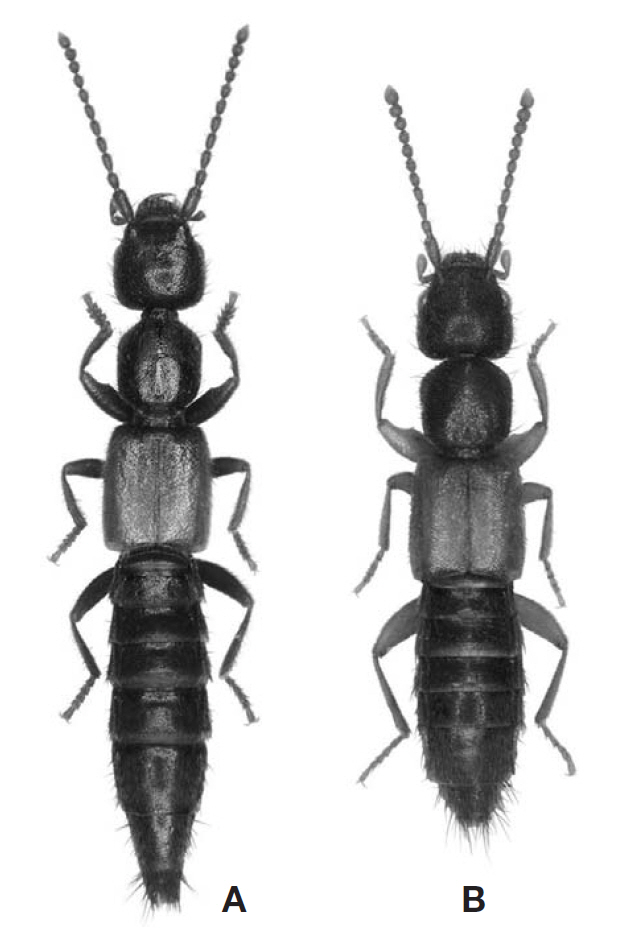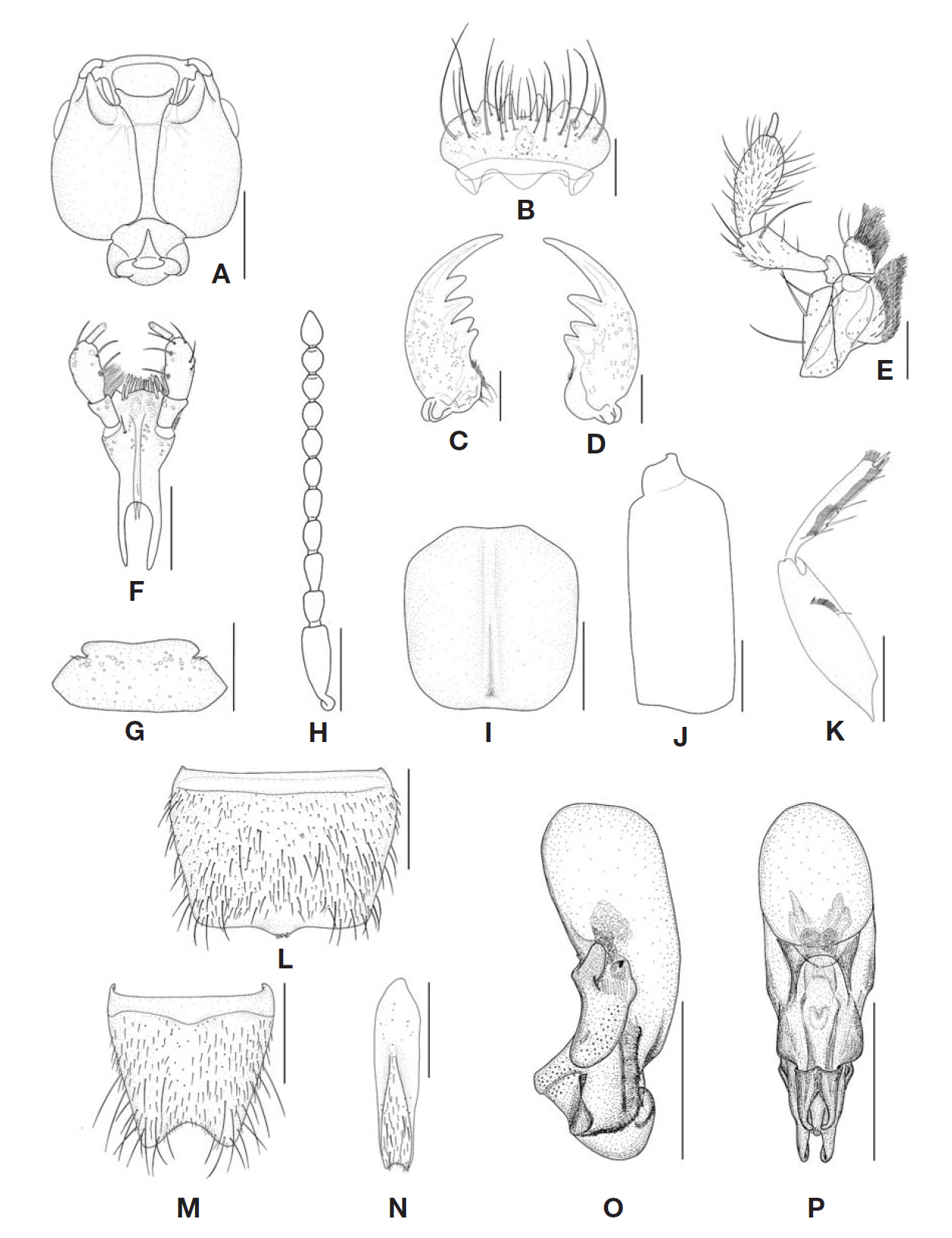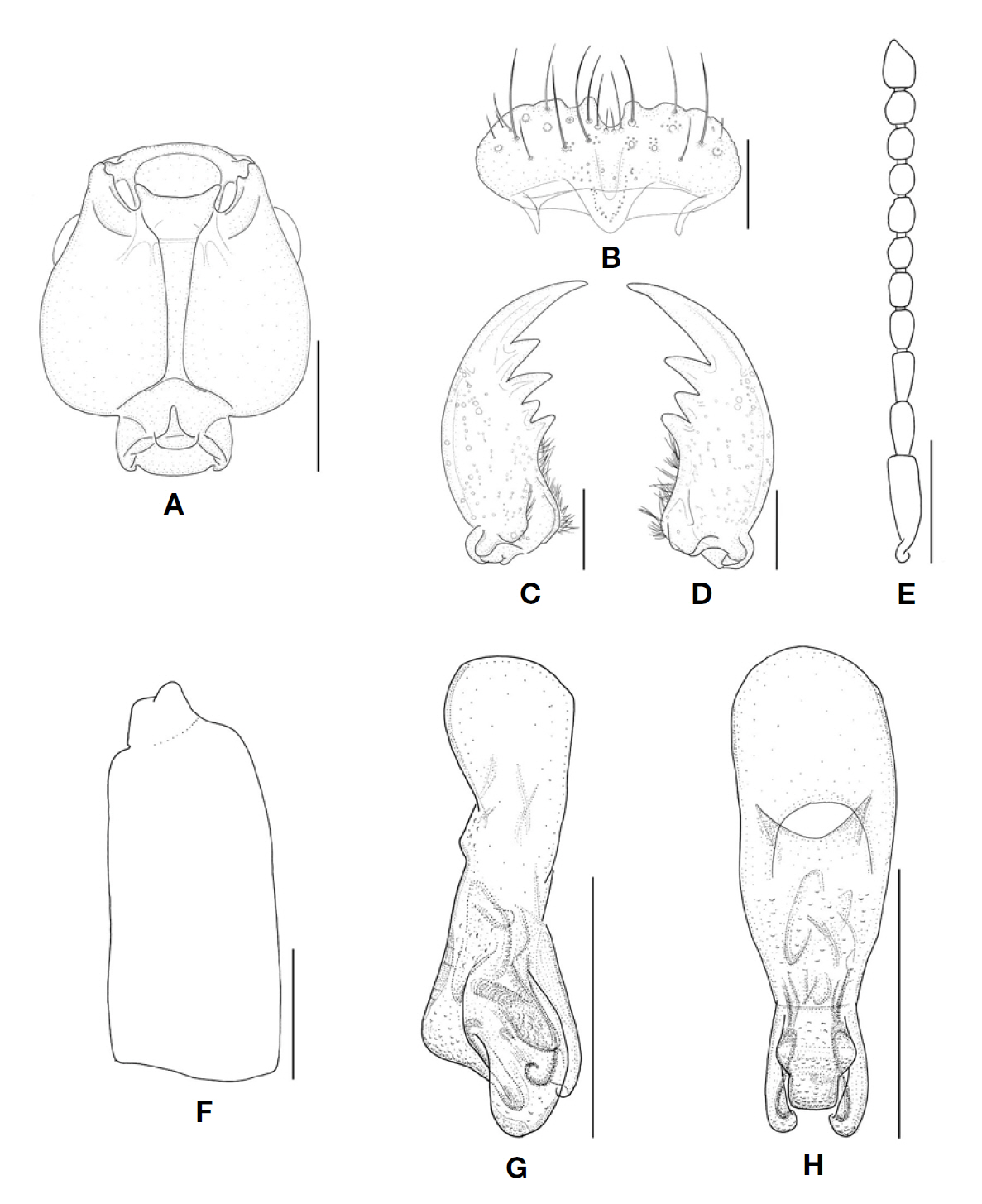



Approximately 400 staphylinid species confined to seashore habitats have been identified worldwide and 31 species in 14 genera are known in Korea (Frank and Ahn, in press). While preparing a checklist of the Korean coastal Staphylinidae, we recognized the genus
Sharp first described
This paper presents re-descriptions of
Order Coleoptera Linnaeus, 1758
Family Staphylinidae Latreille, 1802
Subfamily Paederinae Fleming, 1821
1*Genus Medon Stephens, 1833
>
Key to the Korean species of the genus Medon
1. Head and pronotum black, feebly impunctated central region present longitudinally and slightly elevated (Fig.1A); antero-medial projections of labrum pointed (Fig.2B); antennomere 3 longer than pedicel (Fig.2 H); front tarsus expanded in both genders; hind tarsus more or less wide and short, basal four tarsomeres combined almost 2.3 times as long as apical most; posterior margin of male sternite VII prolonged with 4-7 spines (Fig.2 L) ????????????????????????????????????????????????????????????????????
- Head and pronotum dark reddish brown, impunctate central region absent (Fig.1 B); antero-medial projections of labrum blunt (Fig.3 B); antennomere 3 as long as the pedicel (Fig.3 E); front tarsus slim in both genders; hind tarsus more or less slim and long, basal four tarsomeres combined almost 2.8 times as long as the apical most; posterior margin of the male sternite VII straight ????????????????????????????????????????????????????????????????????????????????
1*Medon
Korea: Gangwon Prov.: 1♀, Gangneung-si, Gangmun-dong, Gangmun beach, 37°83′79′′N, 128°87′74′′E, 24 Jul 2003, Park SJ, Jeon MJ, under seaweeds (CNUIC, Daejeon); Gyeongbuk Prov.: 1♂, Pohang-si, Buk-gu, Cheongha-myeon, Cheongjin-ri, 36°10′37.8′′N, 129°23′38.0′′E, 9 m, 27 Aug 2010, Kim TK, Kim YH, Song JH, Lee SG, Jeon JH, under seaweeds (CNUIC, Daejeon); 20♂♂ 22♀♀ (2♂♂ 1♀, on slides), Uljin-gun, Buk-myeon, Nagok-ri, Nagok beach, 37°07′35.1′′N, 129°22′16.7′′E, 13 m, 30 May 2008, Ahn KJ, Lee JG, Kim TK, under seaweeds (CNUIC, Daejeon); Gyeongnam Prov.: 1♂ 1♀ (1♂, on slide), Geoje-si, Gabae-ri, 1 Jul 2000, Ahn KJ, Kim HJ, Jeon MJ, under seaweeds (CNUIC, Daejeon).
Body length 4.0-4.3 mm. Head, pronotum, scutellum and its surrounding area, and abdomen black; mouthparts, antenna, and elytra reddish brown. Head (Figs. 1A, 2A) rectangular, somewhat coarse punctures densely covered, about 1.06 times as wide as long, frons more or less depressed, feebly impunctated central region present longitudinally and slightly elevated, ventral surface covered with microsculpture and fine punctures; antenna inserted lateral-under sides of front of head, insertion invisible from above; tempora about 2.5 times as long as eye; gular sutures closest after middle (Fig.2 A); labrum (Fig.2 B) broad, anterior margin with two pairs of projections, medial one pointed, lateral one broad, antero-lateral margin serrate, lateral margin round; mandible curved inwardly, right mandible (Fig.2 C) with four internal teeth, basal first smaller than second, left mandible (Fig.2 D) with three internal teeth; inner surface of galea and lacinia fringed with long setae (Fig.2 E); maxillary palpomere 1 small, about 1.5 times as long as wide, palpomere 2 expanded apically, little curved inwardly, about 2.5 times as long as wide, palpomere 3 pear-shaped, widest apical third, almost 2.4 times as long as wide, palpomere 4 minute, 3.0 times as long as wide (Fig.2 E); epipharynx with V-shaped setose line, antero-medial region covered with spins; labial palpomere 1 little expanded apically, 1.3 times as long as wide, palpomere 2 widest near middle, about 2.1 times as long as wide, palpomere 3 thin, about 3.8 times as long as wide (Fig.2F); mentum (Fig.2 G) trapezoidal, narrowed anteriorly, anterior fourth of lateral margin emarginate; antenna (Fig.2 H) reaching to just behind of pronotum, scape robust, longest, 2.3 times as long as wide, pedicel to antennomere 7 distinctly longer than wide, pedicel about 1.5 times as long as wide, antennomere 3 about 2.0 times as long as wide, little narrower (0.89 times) and longer (1.12 times) than pedicel, antennomeres 4-6 subequal, about 1.5 times as long as wide, antennomeres 7-10 subglobluar, antenomere 7 about 1.3 times as long as wide, antennomeres 8-10 subequal, about 1.1 times as long as wide, antennomere 11 water dropshaped,1.6 times as long as wide, 1.4 times as long as antennomere 10. Pronotum (Fig.2 I) subquadrate, about 1.1 times as long as wide, about 0.9 times as wide and 1.1 times as long as head, widest just behind anterior angle, distinct and shallow punctures present, densely pubescent with dark long setae, impunctate central region present longitudinally elevated, a shallow and narrow furrow present posterior third along midline; prosternum well developed, median area upheaved with short longitudinal carina, prosternal process acute and long, hypomeral projection triangular, well developed. Elytra more or less long, about 1.3 times as wide and
1.3 times as long as pronotum, elytron (Fig.2 J) 2.3 times as long as wide, anterior projection of elytra covered with microsculpture,lateral margins straight and parallel. Front femur stout, apical fourth excavated, antero-ventral part near middle with curved ctenidium; front tibia elongate, basal fourth of inner margin digged, anterior-ventral part with two ctenidiums along tibia, basal one short and end on basal third, another one long and continued apically (Fig.2 K); front tarsus expanded in both sexes, each tarsomere about 2.0 times as wide as long; hind tarsus more or less wide and short, 6.4 times as long as wide, basal four tarsomeres combined almost 2.3 times as long as apical most, tarsomere 2 almost as long as wide. Aedeagus as in Fig.2 O, P.
>
Male secondary sexual characteristics.
Postero-median margin of sternite VII prolonged with 4-7 small spines (Fig.2L); posterior margin of sternite VIII emarginate, sternal suture sinuate (Fig.2 M); apical margin of sternite IX weakly emarginate (Fig.2 N); tergite X covered with scattered setae, apical margin with numerous pubescence.
Korea and Japan (Amakusa, Iwoshima and Yokhohama).
>
1*Medon rubeculus Sharp (Figs. 1B, 3)
Korea: Gangwon Prov.: 1♂ 2♀♀(on slides), Donghae-si, Donghae-hang, 37°49′10′′N, 129°14′54′′E, 25 Jul 2003, Jeon MJ, under seaweeds (CNUIC, Daejeon); 1♀, Donghae-si, Mukpohang, 37°54′22′′N, 129°11′36′′E, 25 Jul 2003, Park JS, under seaweeds (CNUIC, Daejeon); Chungnam Prov.: 1♀, Seocheon-gun, Jongcheon-myeon, Jangchon-ri, 36°′05′22.4′′N, 126°38′46.6′′E, 6 m, 4 Oct 2010, Lee SG, under seaweeds (CNUIC).
This species is similar to
Korea, China (Hong Kong) and Japan (Iwaki and Sapporo).


